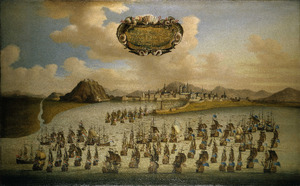James O'Hara, 2nd Baron Tyrawley facts for kids
Quick facts for kids
The Lord Tyrawley
|
|
|---|---|
| Born | 1682 Ireland |
| Died | 14 July 1774 (aged 91 or 92) Twickenham, London |
| Buried | |
| Allegiance | |
| Service/ |
|
| Years of service | 1703–1773 |
| Rank | Field Marshal |
| Battles/wars | War of the Spanish Succession Seven Years' War |
Field Marshal James O'Hara, 2nd Baron Tyrawley and 1st Baron Kilmaine (born in 1682 – died July 14, 1774) was an Irish officer in the British Army. He served in important wars like the War of the Spanish Succession and the Seven Years' War. He also worked as a British ambassador in different countries and was the Governor of Gibraltar.
Contents
Early Military Life

James O'Hara was born in 1682. His father was Charles O'Hara, 1st Baron Tyrawley. James started his army career as a lieutenant in the Royal Fusiliers in 1703. Two years later, in 1705, he became a captain.
He fought in the War of the Spanish Succession. He was at the Siege of Barcelona in 1706 and was hurt at the Battle of Almansa in 1707. He then moved to the Low Countries (modern-day Belgium and Netherlands) and worked for the famous Duke of Marlborough. He was wounded again at the Battle of Malplaquet in 1709.
In 1713, James O'Hara took over from his father as the leader (colonel) of the Royal Fusiliers. He served with his regiment in Minorca for several years. In 1722, he was given the title Baron Kilmaine. In 1724, he also became the 2nd Baron Tyrawley after his father passed away.
Diplomat and General
In 1727, Lord Tyrawley and Kilmaine became the British ambassador to Lisbon, Portugal. He built a strong relationship with King John V. He was promoted to brigadier-general in 1735 and to major-general in 1739. He also became the colonel of the 5th Regiment of Horse.
After leaving Lisbon in 1741, he was promoted to lieutenant-general in 1743. Later that year, he became the British ambassador to Saint Petersburg, Russia. He left this role in 1745.
Lord Tyrawley continued to lead different regiments, including the Coldstream Guards from 1755.
Governor of Gibraltar
In 1756, Tyrawley became the Governor of Gibraltar. He worked hard to make the forts stronger. However, his changes were criticized by William Skinner, the British Chief Engineer. Both men had to explain their actions to the House of Commons. Tyrawley later became the Governor of Portsmouth in 1759.
Later Years and Field Marshal
In 1761, Lord Tyrawley was promoted to full general. He returned to Lisbon in 1762 as both ambassador and commander of British troops during the Seven Years' War. However, he was soon replaced and returned to England.
On June 10, 1763, he reached the highest rank in the army: Field Marshal. He passed away on July 14, 1774, at Twickenham and was buried at the Royal Hospital Chelsea.
Family Life
In 1724, Lord Tyrawley and Kilmaine married Mary Stewart. They did not have children together. However, he had other children, including Charles O'Hara, who also joined the army, and George Anne Bellamy, who became an actress.
Images for kids
| Military offices
|
||
|---|---|---|
| Preceded by The Lord Tyrawley |
Colonel of The Royal Regiment of Fuzileers 1713–1739 |
Succeeded by William Hargrave |
| Preceded by Thomas Pearce |
Colonel of the 5th Regiment of Horse 1739–1743 |
Succeeded by John Brown |
| Preceded by The Earl of Crawford |
Captain and Colonel of the 2nd Troop Horse Grenadier Guards 1743–1745 |
Succeeded by The Earl of Rothes |
| Preceded by The 2nd Earl of Albemarle |
Captain and Colonel of the 3rd Troop of Horse Guards 1745–1746 |
Regiment disbanded |
| Preceded by Francis Columbine |
Colonel of The Lord Tyrawley's Regiment 1746–1749 |
Succeeded by Edward Pole |
| Preceded by Archibald Hamilton |
Colonel of the 14th Regiment of Dragoons 1749–1752 |
Succeeded by Louis Dejean |
| Preceded by Humphrey Bland |
Colonel of the 3rd (King's Own) Regiment of Dragoons 1752–1755 |
Succeeded by The 3rd Earl of Albemarle |
| Preceded by The 2nd Earl of Albemarle |
Colonel of the Coldstream Regiment of Foot Guards 1755–1773 |
Succeeded by The Earl Waldegrave |
| Preceded by Earl of Stair |
Governor of Minorca 1747–1756 |
Succeeded by Hyacinthe Gaëtan de Lannion |
| Preceded by Thomas Fowke |
Governor of Gibraltar 1756–1757 |
Succeeded by The Earl of Home |
| Preceded by Henry Hawley |
Governor of Portsmouth 1759–1773 |
Succeeded by Edward Harvey |
| Peerage of Ireland | ||
| Preceded by Charles O'Hara |
Baron Tyrawley 1724–1774 |
Extinct |
| New creation | Baron Kilmaine 1722–1774 |
|


